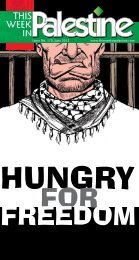Municipalities and Councils - Australians for Palestine
Municipalities and Councils - Australians for Palestine
Municipalities and Councils - Australians for Palestine
You also want an ePaper? Increase the reach of your titles
YUMPU automatically turns print PDFs into web optimized ePapers that Google loves.
Beit Sahour Municipality<br />
Excellence in Community Development<br />
The buzzwords in Beit Sahour<br />
Municipality today are community<br />
(civil) engagement <strong>and</strong> networking.<br />
This particular Palestinian municipality<br />
has been setting <strong>and</strong> surpassing<br />
the benchmark in activities involving<br />
engagement <strong>and</strong> networking.<br />
Beit Sahour is a small but fairly wellknown<br />
town, located 1.5 kilometres<br />
east of Bethlehem. Religiously <strong>and</strong><br />
historically speaking, it is believed to be<br />
the site where the angels proclaimed<br />
to the shepherds the birth of Jesus<br />
Christ. Consequently, there are two main<br />
religious sites that commemorate the<br />
angels’ visit to Beit Sahour: the Greek<br />
Orthodox Shepherds’ Field Church <strong>and</strong><br />
the Franciscan Shepherds’ Field Church.<br />
To commemorate the announcement<br />
of Jesus’ birth, the municipality, in<br />
cooperation with many local<br />
organisations, hosts the annual Great Joy<br />
Celebration, which kicks off the Christmas<br />
season’s festivities. The celebration,<br />
which includes a c<strong>and</strong>lelight procession<br />
<strong>and</strong> per<strong>for</strong>mances from all four of the<br />
community’s scout troops, finishes with<br />
the lighting of the Christmas tree, which<br />
is attended by thous<strong>and</strong>s of Palestinians<br />
(from both inside <strong>and</strong> outside of the<br />
Green Line) <strong>and</strong> internationals each year.<br />
This heritage <strong>and</strong> these sites encourage<br />
pilgrimages of approximately 2,000<br />
tourists per day. Consequently, the<br />
town has developed the supporting<br />
infrastructure to take advantage of <strong>and</strong><br />
enhance tourism to the area. There are<br />
4 hotels <strong>and</strong> 3 guesthouses operational<br />
in Beit Sahour, as well as one hotel that is<br />
currently under construction. In total, Beit<br />
Sahour can accommodate 700 overnight<br />
tourists. In addition to the accommodation<br />
facilities, the town boasts 19 restaurants<br />
<strong>and</strong> catering halls. Furthermore, 34<br />
percent of the local economy is based<br />
upon the h<strong>and</strong>icraft industry, which<br />
30<br />
By Lubnah Shomali<br />
includes the production of olive wood,<br />
mother of pearl, <strong>and</strong> embroidery items<br />
that are sold here <strong>and</strong> abroad.<br />
Throughout its history, Beit Sahour<br />
has been a model <strong>for</strong> civic engagement.<br />
During the first Intifada, the community<br />
led an innovative campaign of non-violent<br />
resistance that included the boycott<br />
of Israeli goods <strong>and</strong> the refusal to pay<br />
taxes to the Israeli government. Activities<br />
<strong>and</strong> initiatives designed to create selfsufficiency<br />
<strong>and</strong> independence from the<br />
Israeli economy <strong>and</strong> the occupation<br />
were aplenty.<br />
The community of Beit Sahour continues<br />
this non-violent resistance campaign to<br />
this day in the <strong>for</strong>m of a public park. Ush<br />
Ghurab Peace Park was born through the<br />
mutual will of the municipal administration<br />
<strong>and</strong> the community. Originally a military<br />
base that was first utilised by the British<br />
<strong>and</strong> then the Jordanians, the l<strong>and</strong>s now<br />
under the geopolitical label “Area C”<br />
were occupied by the Israelis in 1967. In<br />
addition to the 107 dunams used by the<br />
previous armies, the Israeli army annexed<br />
another 1,500 dunams of Palestinian l<strong>and</strong><br />
surrounding the site as a buffer zone <strong>for</strong><br />
security reasons. The base was used as<br />
a launching point <strong>for</strong> shelling Palestinian<br />
homes during the second Intifada. In April<br />
2006, the Israeli army relocated to a base<br />
near Herodion. The current Beit Sahour<br />
municipal administration took advantage<br />
of this evacuation <strong>and</strong> began developing<br />
a master plan <strong>for</strong> the utilisation of the<br />
area. Gradually, the military base was<br />
trans<strong>for</strong>med from a site that was feared<br />
<strong>and</strong> abhorred to a recreational oasis<br />
with a climbing tower <strong>and</strong> children’s<br />
play areas, picnic <strong>and</strong> barbeque areas,<br />
a restaurant <strong>and</strong> medium-sized hall, a<br />
basketball court, a soccer field, <strong>and</strong> an<br />
outdoor theatre. The community of Beit<br />
Sahour contributed time, money, <strong>and</strong><br />
materials to the project; in fact, every<br />
sector of the community had a h<strong>and</strong> in<br />
the development of Ush Ghurab.<br />
Beit Sahour Municipality manages the<br />
park, which offers a variety of services to<br />
the community. The park has become a<br />
venue <strong>for</strong> numerous community activities<br />
such as the Nights of Beit Sahour<br />
Festival, the Fakkous Festival, sports<br />
tournaments, in<strong>for</strong>mation sessions,<br />
workshops, lunches, dinners, <strong>and</strong><br />
traditional celebrations. The municipality<br />
charges a meagre 2 NIS entrance fee;<br />
that combined with income generated<br />
from the park’s catering, hall rental,<br />
<strong>and</strong> other services contribute to the<br />
sustainability of the park.<br />
The park is not only a symbol of nonviolent<br />
resistance but also of the desire<br />
of the Palestinian people to live in peace,<br />
free from oppression. It is a symbol of<br />
31<br />
their innate right to live in peace <strong>and</strong><br />
security, according to their st<strong>and</strong>ards,<br />
culture, <strong>and</strong> heritage, just as their Israeli<br />
counterparts.<br />
While Ush Ghurab Peace Park is<br />
an outst<strong>and</strong>ing example of community<br />
engagement, networking, <strong>and</strong> sustainable<br />
development, there are many others. The<br />
population of Beit Sahour has more than<br />
doubled from 5,000 inhabitants in 1952,<br />
when the village council was upgraded to<br />
a municipal council, to a little over 13,000<br />
today. Many families, who originally<br />
resided in the city centre, now known<br />
as the Historic City, have relocated to<br />
more spacious areas in the suburbs of<br />
the city. Consequently, the Historic City<br />
contains many ab<strong>and</strong>oned <strong>and</strong> neglected<br />
homes that have become environmental



